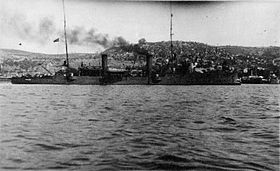Berk-i Satvet
|
|
|
|---|---|
 Berk-i Sevket |
|
| Overview | |
| Type | Torpedo cruiser |
| units | 2 |
| Shipyard |
Germania shipyard , Kiel |
| Launch | November 30, 1906 |
| delivery | November 13, 1907 |
| Commissioning | 1907 |
| Decommissioning | 1945 |
| Whereabouts | 1948 demolition |
| Technical specifications | |
| displacement |
775 t (1907), 850 t (1938) |
| length |
80.1 m between the perpendiculars |
| width |
8.4 m |
| Draft |
4.6 m |
| crew |
105-145 men; |
| drive |
4 Schulz water tube boilers |
| speed |
18 kn , max. 22 kn |
| Range |
3240 nm |
| Armament |
|
| Fuel supply |
240 tons of coal |
| Sister ship |
Peyk-i Şevket |
The Berk-i Şevket was a torpedo cruiser of the Ottoman Navy built in Germany . After the First World War , she joined the new Turkish Navy as a training ship as a training ship as Berk and her sister ship Peyk until the mid-1940s .
Mission history
The Berk-i Satvet was built under construction number 127 parallel to the Peyk-i Şevket at the Germania shipyard and was launched on December 1, 1906.
In the First Balkan War she was in the shipyard at the beginning of the war and in December became a division ship of the 1st destroyer division with the Schichau boats Yadigar-i Millet and Muavenet-i Milliye as well as Taşoz and Basra of the French Durandal type . Before the end of the year, during an advance from the Dardanelles with the cruiser Mecidiye, she tried in vain to put the Greek destroyers Niki and Doxa into action. On January 18, 1913, she was involved with the ships of the line Barbaros Hayreddin , Turgut Reis , Mesudiye , the Mecidiye and destroyers in the second attempt of the Ottoman Navy to break out of the Dardanelles, which failed in the battle of Lemnos against the Greek fleet. From February 9th to 11th, she supported the landing operation against the Bulgarian army at Şarköy on the north bank of the Marmara Sea near Tekirdag with the ships of the line Barbaros Hayreddin and Turgut Reis .
When the Ottoman fleet was first deployed in the First World War against Russia in the Black Sea, it was given the task of bombarding Novorossiysk with the Midilli . The radio station there was put out of action and five Russian ships and the British Friederike were damaged. On December 6, she and her sister ship Peyk-i Şevket , the battle cruiser Yavuz Sultan Selim and the light cruiser Mecidiye secured a large convoy with troops and supplies to Trabzon , which could no longer be called directly because of a Russian minefield.
On January 2, 1915, the Berk-i Satvet was badly damaged by a Russian mine off the Bosporus and was not ready for use again until 1917. From then on, the area of application of the sister ships was covered. Her name was also shortened to Berk in the Turkish Navy . It was decommissioned in 1945 and only demolished in 1955.
Re-use of the names
In 1972 and 1975 the Turkish Navy received two American Claud Jones class escort destroyers built in Turkey , the frigates TCG Berk (D 358) and TCG Peyk (D 359).
literature
Bernd Langensiepen, Ahmet Güleryüz: The Ottoman Steam Navy 1828-1923 , Naval Institute Press, Annapolis 1995, ISBN 1-55750-659-0
Web links
- Berk-i Satvet on Turkey in the First World War
Individual evidence
- ↑ Langensiepen, p. 196
- ↑ On it served from September 1914 to January 1915 the later very successful as a submarine commander Hans-Joachim von Mellenthin .